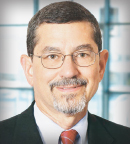“Progress in lung cancer happens by slow steps punctuated by quantum leaps. In the age of perioperative therapies, we are moving one step closer to curing more patients. Surgery is still the intervention most likely to cure patients with earlier-stage disease, but 50% of cases can recur,” said invited discussant David Paul Carbone, MD, PhD, Director of the James Thoracic Center at The Ohio State University.

David Paul Carbone, MD, PhD
“In the previous decade, only the addition of chemotherapy improved outcomes by about 5%. Chemotherapy alone is not an optimal approach. Immunotherapy is an advance, and we need to determine how to select adjuvant and neoadjuvant therapies,” he continued.
“Immunotherapy is safe for patients who could be cured by surgery alone, and we may see a significant survival benefit in the adjuvant and neoadjuvant settings. We need robust biomarkers to select patients for the need for additional therapy and the benefit, particularly given the cost of these therapies,” Dr. Carbone noted. “We have regressed to a one-size-fits-all approach with immunotherapy. We have unlearned the fact that every patient’s tumor is different. We need more robust biomarkers,” he emphasized.
“CheckMate 816 is clearly a positive study. A 25% delta in event-free survival in PD-L1–positive patients is very exciting. In an exploratory analysis, the benefit was stronger in patients with a pathologic complete response, but those who did not achieve a pathologic complete response also benefited from immunotherapy,” he said.
Questions Still to Answer
Questions that remain to be addressed include the following:
- How do we select adjuvant vs neoadjuvant therapy? We need data for adjuvant immunotherapy. Some studies are ongoing.
- CheckMate 816 showed an advantage for three cycles of preoperative therapy and a benefit in patients with a nonpathologic complete response. Perhaps these patients could benefit from additional immunotherapy.
- What are the roles of radiation therapy and adjuvant chemotherapy in these patients? What is the role of neoadjuvant immunotherapy alone?
- What about “oops” driver–mutant disease? There are no data.
“There are many ongoing neoadjuvant phase III trials in NSCLC. The combination of surgery and tyrosine kinase inhibition is less impressive than neoadjuvant immunotherapy plus chemotherapy.” Dr. Carbone commented. “Combining neoadjuvant therapy with surgery is a new standard of care for the first time in decades. It will almost certainly improve survival in early-stage disease,” he stated.
DISCLOSURE: Dr. Carbone reported financial relationships with G1 Therapeutics, AstraZeneca, Bristol Myers Squibb, Boehringer Ingelheim, Curio Science, Daiichi Sankyo, Eisai, AbbVie, Flame Biosciences, Seattle Genetics, Genentech/Roche, GlaxoSmithKline, Gritstone, Janssen, Lilly, Mirati, Regeneron, Sanofi, and EMD Serono/Merck.

